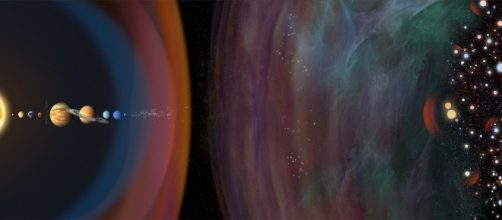NASA launched voyager 1 on September 5, 1977. Its mission at that time consisted on studying the planets Jupiter and Saturn; soon after voyager 11 was lunch to study Uranus and Neptune. Now, their mission is to study the interstellar space. On August 25, 2012, voyager 1 became the first spacecraft to reach interstellar space and voyager 2 is expected to enter the same space region in 2016. Scientists believe that this marks human´s leap into the space between the stars and they are researching on techniques that would allow humans to reach farther distances in space.
What is the interstellar medium(ISM)?
This region in space includes the forms of matter that lies in the space between the stars and other systems in a galaxy. The matter that exists in the interstellar medium consists in gas, dust and cosmic rays. The ISM is composed primarily of hydrogen, followed by helium and traces of oxygen, carbon and nitrogen. Stars form in the region from molecular clouds and and provide the ISM with matter in the form of supernovae, stellar winds and planetary nebulae.
Studying the interstellar medium
Scientists are considering the development of robotic interstellar probes to study the farthest regions in space. They think that the ISM is a valuable science target. Apart from the two voyagers, it believed that more space probes are needed into the ISM to understand more the transition region that separates the sun´s bubble of plasma from the interstellar wind.
Scientists believe that a concept of the next robotic space probe could reach the boundary of interstellar space known as the heliopause in just 10 years, as opposed to the 36 years that took voyager 1 to reach it.
Solar gravitational lensing
In the same way that astronomers use the light from distant galaxy that bends over a foreground galaxy to observe the more distant one, the sun could be used as a lens in which a spacecraft, positioned outside the solar system, would be able to observe exoplanets and the their features. The space telescope positioned there would take close ups of planets orbiting other stars. It would allow seeing detailed images of planets like never before.
Scientists think that this could be achieved given there are more developments on propulsion, power communication robotics and life support in space. The journey to Mars (Mars exploration), is one mission that could be laying the foundations for the fulfillment of these space enterprises.

